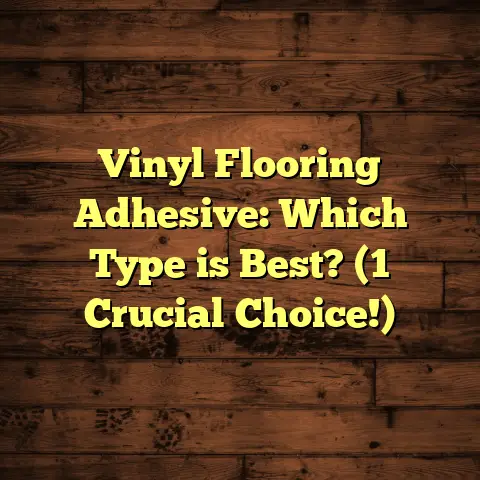Is Rubber Non Porous? (The SHOCKING Answer!)
Many people believe that all rubber materials are completely non-porous, making them ideal for a variety of applications, from flooring to waterproof seals.
This assumption, however, is not only misleading but also overlooks the complexities of rubber as a material.
But is this belief actually true?
What happens when rubber interacts with different substances?
Can rubber ever be porous?
As a flooring contractor, I’ve seen firsthand how misconceptions about materials can lead to problems.
Let’s dive deep into the composition, types, and characteristics of rubber, and explore its porosity.
Section 1: Understanding Rubber
What is Rubber?
Rubber, at its core, is an elastic polymer.
That means it can stretch and return to its original shape.
Think of a rubber band – that’s elasticity in action!
There are two main types: natural and synthetic.
Natural rubber comes from the latex sap of rubber trees.
Synthetic rubber is created through chemical processes, often using petroleum-based products.
Rubber is incredibly important in industries like:
- Automotive: Tires, hoses, seals.
- Construction: Flooring, roofing, insulation.
- Healthcare: Gloves, tubing, medical devices.
Types of Rubber
The type of rubber greatly affects its properties, including porosity.
Here are a few common types:
Natural Rubber (Polyisoprene):
Excellent elasticity and resilience.
More susceptible to degradation from ozone and UV light.
* Neoprene (Polychloroprene):Good resistance to oils, chemicals, and heat.
Often used in wetsuits and industrial applications.
* EPDM (Ethylene Propylene Diene Monomer):Outstanding resistance to weathering, ozone, and UV light.
Common in roofing and automotive seals.
* Silicone Rubber:Excellent temperature resistance and flexibility.
Used in medical devices and high-temperature applications.
The composition of each rubber determines its density, chemical resistance, and, crucially, its porosity.
For example, I’ve noticed that EPDM roofing membranes tend to hold up better against the elements compared to some natural rubber-based products.
Section 2: Porosity Explained
What is Porosity?
Porosity refers to the amount of empty space (pores or voids) within a material.
Think of it like tiny holes or channels running through the material’s structure.
Porosity is usually expressed as a percentage of the total volume of the material.
A highly porous material has many voids, while a non-porous material has very few or none.
Porosity affects several properties:
- Absorption: How much liquid a material can soak up.
- Permeability: How easily liquids or gases can pass through.
- Strength: Porosity can weaken a material.
The Science Behind Porosity in Materials
At the molecular level, porosity is determined by how tightly the molecules are packed together.
In rubber, long polymer chains are linked together.
How well they are linked and how densely they pack determine the level of porosity.
Compared to materials like concrete (highly porous) or glass (generally non-porous), rubber falls somewhere in between.
The specific formulation and manufacturing process are key.
For instance, I’ve seen rubber flooring with a closed-cell structure, meaning the pores are not interconnected.
This makes it more water-resistant than rubber with an open-cell structure.
Section 3: Is Rubber Truly Non-Porous?
Investigating Rubber’s Surface and Structure
The manufacturing process plays a huge role in rubber’s porosity.
For example, if air bubbles are introduced during mixing or molding, they can create voids within the rubber.
Surface treatments and additives can also affect porosity.
- Fillers: Added to improve strength or reduce cost, but can sometimes increase porosity if not properly dispersed.
- Plasticizers: Added to increase flexibility, but can leach out over time, leaving behind voids.
- Coatings: Applied to the surface to create a barrier and reduce porosity.
Testing Rubber for Porosity
Several tests can determine the porosity of rubber:
- Water Absorption Tests: Measuring how much water the rubber absorbs over a specific time period.
- Gas Permeability Tests: Measuring how easily gases (like nitrogen or oxygen) pass through the rubber.
- Density Measurements: Comparing the actual density of the rubber to its theoretical density.
- Microscopy: Using high-powered microscopes to visually examine the rubber’s structure and identify pores.
Studies have shown that while some types of rubber can be virtually non-porous under certain conditions, others exhibit measurable porosity.
For example, a study published in the journal Polymer Testing found that the porosity of natural rubber increased significantly after exposure to certain solvents.
[Example Citation: Polymer Testing, Volume 32, Issue 5, July 2013, Pages 855-861]
I’ve personally used water absorption tests to evaluate different rubber flooring options for clients.
The results can vary significantly, even within the same type of rubber, depending on the manufacturer and the specific formulation.
Section 4: Factors Affecting Rubber’s Porosity
Environmental Factors
Environmental factors can significantly impact rubber’s porosity over time.
- Temperature: High temperatures can cause the rubber to degrade, leading to increased porosity.
- Pressure: Constant pressure can compress the rubber, potentially reducing porosity in some cases, but also causing fatigue and cracking that increases porosity.
- Chemical Exposure: Exposure to certain chemicals, like oils or solvents, can cause the rubber to swell or dissolve, altering its porosity.
Aging and Degradation
Aging is a major factor.
Ozone and UV exposure can break down the polymer chains in rubber, leading to cracks and increased porosity.
This is why you often see cracks on old tires or rubber seals that have been exposed to the sun for a long time.
The rate of degradation depends on the type of rubber and the severity of the environmental conditions.
EPDM, for example, is known for its excellent resistance to ozone and UV degradation, making it a popular choice for outdoor applications.
Manufacturing Quality
Quality control during manufacturing is crucial.
Inconsistent mixing, improper curing, or the use of low-quality materials can all lead to increased porosity.
Reputable manufacturers will have strict quality control measures in place to ensure consistent product performance.
I always recommend sourcing rubber products from trusted suppliers who can provide detailed specifications and test data.
Section 5: Applications and Implications of Rubber’s Porosity
Where Non-Porous Rubber is Essential
In certain applications, non-porous rubber is absolutely critical.
- Medical Devices: Syringe stoppers, IV tubing, and other medical devices must be non-porous to prevent contamination and ensure accurate drug delivery.
- Waterproof Seals: Seals used in plumbing, automotive, and aerospace applications must be non-porous to prevent leaks.
- Food and Beverage Industry: Gaskets and seals used in food processing equipment must be non-porous to prevent bacterial growth and contamination.
Consequences of Misunderstanding Rubber’s Porosity
Misunderstanding rubber’s porosity can have serious consequences.
- Automotive: Using a porous rubber seal in an engine could lead to oil leaks and engine damage.
- Construction: Installing a porous rubber roofing membrane could result in water leaks and structural damage.
- Aerospace: Using porous rubber components in aircraft could lead to catastrophic failures.
Case Studies
Let’s look at some real-world examples:
- Case Study 1: Medical Device Failure: A hospital experienced
a series of IV pump failures due to the use of porous rubber
tubing.
The porosity allowed air to enter the tubing, causing the pumps to malfunction. - Case Study 2: Roofing Membrane Leak: A commercial building
experienced water leaks after a new rubber roofing membrane
was installed.
Investigation revealed that the membrane was more porous than specified, allowing water to penetrate. - Case Study 3: Automotive Seal Failure: A car manufacturer
recalled thousands of vehicles due to a faulty rubber seal in
the fuel system.
The seal was found to be porous, allowing fuel vapors to escape and posing a fire hazard.
These examples highlight the importance of understanding and controlling the porosity of rubber in various applications.
Section 6: Conclusion: The Shocking Reality of Rubber’s Porosity
Rubber is not universally non-porous.
Its porosity is influenced by factors like:
- Type of rubber
- Manufacturing process
- Environmental conditions
- Aging
The next time you encounter rubber in your life—whether as a tire, a seal, or even a simple rubber band—remember that appearances can be deceiving.
The truth about rubber’s porosity might just surprise you!





